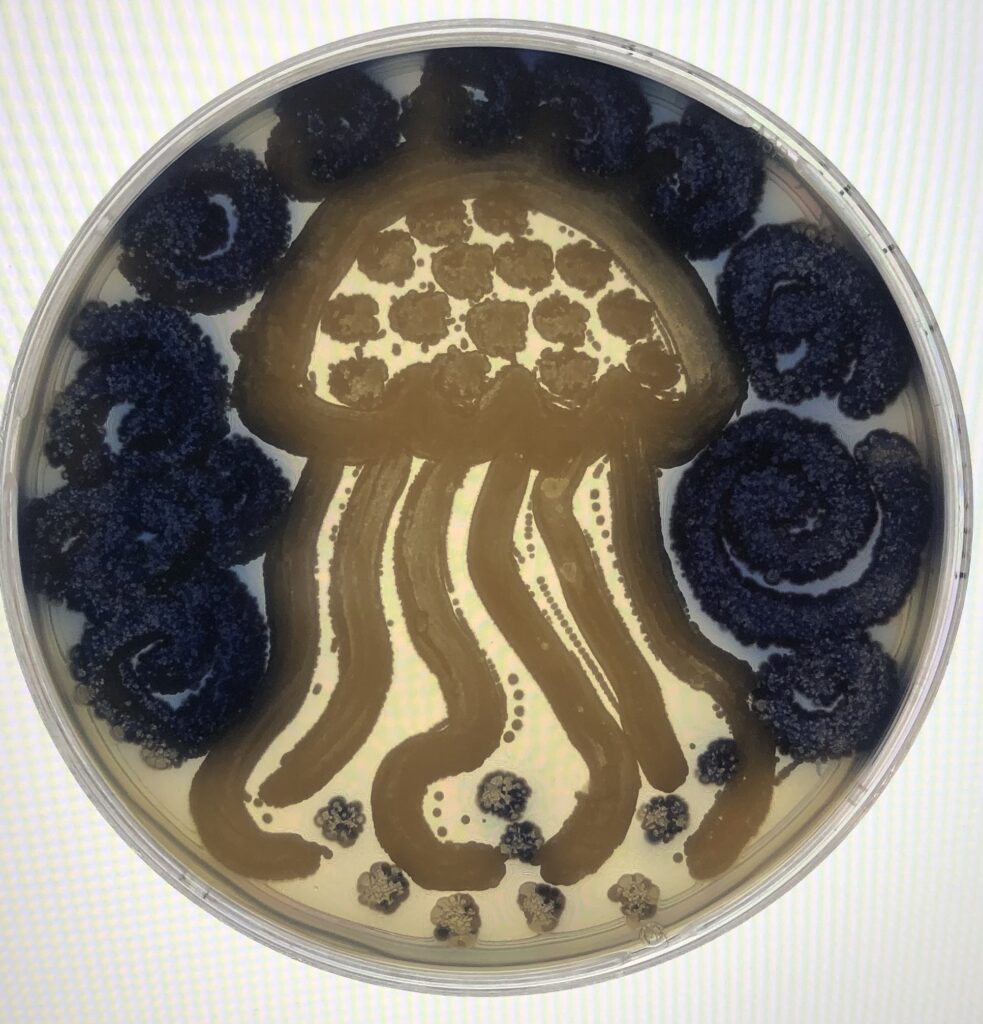Natural Product Biosynthesis Research in an Undergraduate-Fueled Laboratory
Over half of all antibiotics and anticancer agents used in medicine today are derived from molecules produced by plants, bacteria, and fungi. These molecules are broadly defined as natural products based on their chemical components and natural source. Our lab is inspired and humbled by the observation that many of the molecules found in nature are more complicated than what humans can synthesize in a laboratory setting. We seek to elucidate the molecular underpinnings of how nature makes these molecules so that we can apply this information to gain access to new medicinally relevant molecules via environmentally sustainable routes.
The goals of our research program are three-fold: 1) Expose students to a range of modern chemical/biochemical research concepts and techniques; 2) Help move the needle of the field towards accessing important molecules via environmentally sustainable routes; and 3) Empowering diverse, science-appreciative, ethical, and compassionate citizens ready to tackle the emerging challenges of our times.
How Can We Study the Transient and Highly Coordinated Events Involved in Natural Product Biosynthesis?

Acyl carrier proteins (ACPs) play a central role in the biosynthesis of a range of natural products. Despite being a focus of study for decades, there is a dearth of data to support how ACPs orchestrate high fidelity biosynthetic processes. This is because the fast motions and flexible nature of ACPs make their structures difficult to capture via traditional chemical approaches. In collaboration with Casey Londergan (Haverford Chemistry), our research team has developed new spectrophotometric methodologies that enable us to study the fast and transient interactions of ACPs at a temporal resolution that was previously inaccessible. Specifically, we have shown that incorporation of site-specific vibrational spectroscopic probes onto the ACP or its molecular cargo can provide important information about the environment of biosynthetic intermediates on a previously inaccessible temporal resolution (the pico- to femto-second timescale). Notably, this method not only provides improved temporal resolution but also requires significantly less resources (time, materials, cost) than traditional methods in the field. We have also developed an approach to obtain and visualize lucrative ACP-protein complexes that occur during the biosynthetic process. These methodological developments have unlocked the ability to take important (and previously inaccessible) “snap shots” of the ACP and its interactions with molecules. Our lab and others have applied this methodology to other natural product biosynthetic enzymes and are now leveraging these advances to understand complex protein-molecule interactions. For example, we are studying the interplay between ACP amino acid sequence and molecular cargo identity in directing the phenomenon called “chain sequestration,” which is thought to play a critical role in directing biocatalysis. We are also studying how chain sequestration affects ACP-protein interactions. We hypothesize that these subtle changes in structure could be the molecular “language” the ACP uses to orchestrate the highly coordinated movements of the synthase to build structurally complex molecules in such high fidelity.
What are Unique Access Points to Study Natural Product Biosynthesis?
Microbial enzymes work together as a team (or synthase) in the biosynthesis of natural products. The proteins that comprise type II polyketide synthases (PKSs) and fatty acid synthases are powerful biocatalysts capable of making complex and difficult molecular connections and transformations. Understanding these proteins at a molecular level and strategically applying this information could enable cost-effective and sustainable access to molecules that benefit society. Yet, progress towards this goal has been stymied by the inability to obtain key type II PKS components in a state that they can be studied in the laboratory. This is a major barrier of the field that our team has addressed head-on by: 1) identifying type II PKS BGCs in phyla (a principal taxonomic category that ranks above class and below kingdom) that had been previously unexplored and 2) discovering that genes encoding for key biosynthetic enzymes housed within unexplored phyla are amenable to being expressed (converted from DNA sequence to protein) in the robust heterologous host Escherichia. coli.
Our work has has set the stage to tackle foundational questions such as: 1) What features influence whether non-actinomycete type II PKS enzymes can be heterologously expressed in E. coli as stable proteins? and 2)Can we understand/predict the compatibility of type II PKS ACPs with other biosynthetic enzymes? Ultimately, we aim to overcome the ~30-year barrier to reconstituting type II PKSs in vitro (outside the living organism), which would transform our ability to strategically design these systems to gain sustainable access to important chemical diversity.

Educational Research: How do Intrapersonal Factors Affect Student Learning, Attitudes and Mindsets in Science Education?
Today, more than ever, we need a future generation of community members and innovators who are ready to adaptively respond to the unexpected and display resilience when faced with setbacks. However, we understand very little about how these skills manifest in STEM contexts broadly, and how they are developed by STEM undergraduate students. Practicing effective failure management is an important skill for researchers, but the opportunity to learn it is lacking in most undergraduate research contexts. Moreover, we also lack validated measurements to assess relevant factors such as student coping and fear of failure in STEM contexts. Through FLAMEnet, we conduct educational research and bring together key stakeholders to innovate in the realm of inclusive STEM practices. We have published several papers on these theoretical frameworks, including work on exploring student coping behaviors and fear of failure. These measures are now being used by teams of researchers across the country to develop interventions targeted to support adaptive coping strategies and reduce fear of failure. Further, we generated a model representing hypotheses of how students might approach challenges and respond to failures in undergraduate STEM learning contexts, and we are currently supporting researchers in exploring how this framework can be leveraged to build more inclusive and diverse STEM training environments and workforces.
